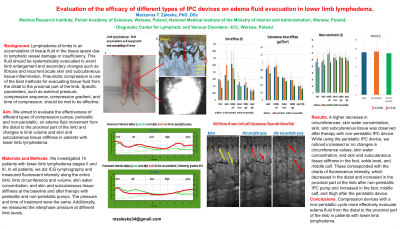Clinical Research
(CR-086) Evaluation of the Efficacy of Different Types of IPC Devices on Edema Fluid Evacuation in Lower Limb Lymphedema
Friday, May 2, 2025
7:45 PM - 8:45 PM East Coast USA Time

Introduction: Lymphedema of limbs is an accumulation of tissue fluid in the tissue space due to lymphatic vessel damage or insufficiency. This fluid should be systematically evacuated to avoid limb enlargement and secondary changes such as fibrosis and recurrent acute skin and subcutaneous tissue inflammation. Pneumatic compression is one of the best methods for evacuating tissue fluid from the distal to the proximal part of the limb. Specific parameters, such as external pressure, compression sequence, compression gradient, and time of compression, should be met to be effective.
Aim.
We aimed to evaluate the effectiveness of different types of compression pumps, ascending and peristaltic, on edema fluid movement from the distal to the proximal part of the limb and changes in limb volume and skin and subcutaneous tissue stiffness in patients with lower limb lymphedema.
Methods: We investigated 10 patients with lower limb lymphedema stages II and III. In all patients, we did ICG lymphography and measured fluorescent intensity along the entire limb, limb circumference and volume, skin water concentration, and skin and subcutaneous tissue stiffness at the baseline and after therapy with peristaltic and ascending pumps. The pressure and time of treatment were the same. Additionally, we measured the interphase pressure at different limb levels.
Results: A higher decrease in circumferences, skin water concentration, skin, and subcutaneous tissue was observed after therapy with an ascending IPC device. While using the peristaltic IPC device, we noticed increased or no changes in circumference values, skin water concentration, and skin and subcutaneous tissue stiffness in the foot, ankle level, and middle calf. These corresponded with the charts of fluorescence intensity, which decreased in the distal and increased in the proximal part of the limb after ascending the IPC pump and increased in the foot, middle calf, and thigh after the peristaltic device.
Discussion: Compression devices with an ascending cycle more effectively evacuate edema fluid from the distal to the proximal part of the limb in patients with lower limb lymphedema.
Aim.
We aimed to evaluate the effectiveness of different types of compression pumps, ascending and peristaltic, on edema fluid movement from the distal to the proximal part of the limb and changes in limb volume and skin and subcutaneous tissue stiffness in patients with lower limb lymphedema.
Methods: We investigated 10 patients with lower limb lymphedema stages II and III. In all patients, we did ICG lymphography and measured fluorescent intensity along the entire limb, limb circumference and volume, skin water concentration, and skin and subcutaneous tissue stiffness at the baseline and after therapy with peristaltic and ascending pumps. The pressure and time of treatment were the same. Additionally, we measured the interphase pressure at different limb levels.
Results: A higher decrease in circumferences, skin water concentration, skin, and subcutaneous tissue was observed after therapy with an ascending IPC device. While using the peristaltic IPC device, we noticed increased or no changes in circumference values, skin water concentration, and skin and subcutaneous tissue stiffness in the foot, ankle level, and middle calf. These corresponded with the charts of fluorescence intensity, which decreased in the distal and increased in the proximal part of the limb after ascending the IPC pump and increased in the foot, middle calf, and thigh after the peristaltic device.
Discussion: Compression devices with an ascending cycle more effectively evacuate edema fluid from the distal to the proximal part of the limb in patients with lower limb lymphedema.

.jpg)